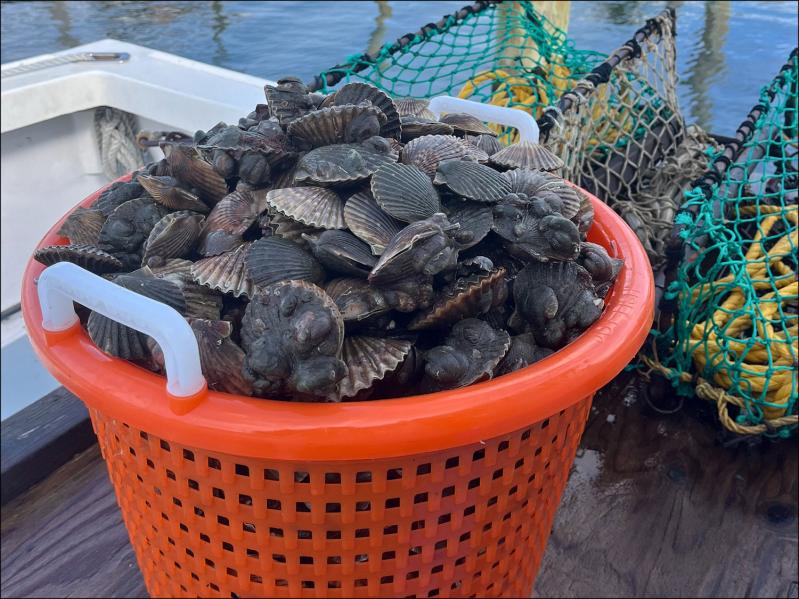The season to harvest our beloved bay scallop opens in state waters at sunrise on Nov. 3. Sadly, as has happened for the past six years or so, the once-plentiful and highly savored bivalve again suffered an extreme die-off during the latter stages of summer.
It’s disappointing but not surprising news. I’m currently debating whether I will lug my eight heavy iron dredges out of the basement to put on Rock Water, but right now, my answer leans to a solid “no.”
“So, adult (harvestable) wild bay scallop populations are very low this year, similar to every year since the first mass die-off in 2019,” confirmed Harrison Tobi, an aquaculture and scallop specialist with the Cornell Cooperative Extension Center in Southold.
“Yeah, I’ve heard the same sad news again,” said Colin Mather, the longtime owner of the Seafood Shop in Wainscott, when I dropped by his establishment on Saturday. “It’s very disappointing.” Mather, who lives a block or two from me on North Haven, has seen it all.
However, Tobi said there is a slight glimmer of hope for next fall. “We are still seeing good recruitment, meaning that the bay scallop population from 2024 had multiple spawns in 2025 prior to the months of August and September, when we see drastic declines in adult populations.”
“We know that there were multiple spawning events from May through August from our spat collectors deployed throughout the Peconics, and had very high densities of juvenile bay scallops,” he added. “Additionally, our lantern nets that hold C.C.E.-produced bay scallops in Orient Harbor, had large numbers of wild juvenile bay scallops that were set within the nets.”
“Similarly, the aquaculture gear holding bay scallops for our comparative field studies in Orient Harbor, Northwest Harbor, and Flanders all had significant numbers of natural-set juvenile bay scallops within the gear,” he observed. “These findings reiterate that the Peconic Bay scallop populations are surviving as a species, but not as a commercially viable species.”
Ugh.
Tobi is passionate in monitoring and finding solutions to restore our once plentiful scallop.
As part of his work, in addition to spending plenty of time in the lab and studying the bay bottom, he carefully monitors over 20 dive sites spanning the entire Peconic estuary system, which comprises more than 100 bays, harbors, and tributaries between Riverhead and Montauk Point. That’s a lot of water to cover.
“I keep getting asked by fellow researchers and curious individuals how I will judge if this research and restoration is working, and the answer is simple,” he said: “Once baymen start catching scallops again.”
“We can make conjectures all day, and be intrigued by our research results, but at the end of the day, all of this research is to restore this economically important fishery,” he said. “It’s to help our communities. It’s to help the baymen. It’s to help their families.”
Tobi added that “being a new father myself, I can’t even imagine the hardship and heartbreak our local baymen must feel. With the opening of the season being in November, I am sure a lot of families relied on this fishery to buy Christmas gifts for the little ones. It’s hard to fathom the impact this must have had and still has on the families of our local baymen.”
“I love science, but what really drives my team, and myself, is the fact that this research can have a positive impact on our communities.”
As background, until the mid-1980s, bay scallops supported a commercial fishery on the East End with a dockside value of up to $2 million per year. Including economic multipliers, the fishery annually contributed more than $10 million to our local economy.
For the well-over 500 full-time baymen, bay scallops were once their primary source of income. Folks made quite a decent living by every account. But that’s well in the past.
The unfortunate story of the demise of our bay scallop began in 1985, when a series of brown tide algal blooms decimated our scallop populations and pushed them almost to extinction for a number of years. With the disappearance of the scallop fishery, most baymen had to leave the water and find other jobs, retire, or move out of state.
Very few full-time baymen work our local waters today. In recent years, marine researchers like Tobi have additionally discovered that a deadly parasite also afflicts our scallops just after they spawn in early June.
Hopefully, committed folks like him can bring our once prominent bay scallop back.
On the local fishing scene, the action has been productive on many fronts.
“The fall run is on for many fish,” remarked Sebastian Gorgone at Mrs. Sam’s Bait and Tackle in East Hampton. “Fluke have been running strong out at Montauk, and the false albacore remain thick in many areas. Porgies and sea bass are plentiful, and the action along the ocean beaches, especially east near Montauk, has been great for striped bass, bluefish, and albies too.”
—
Fishing tips, observations, and photographs can be sent to [email protected].

